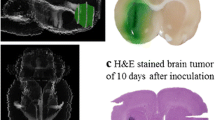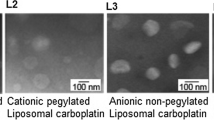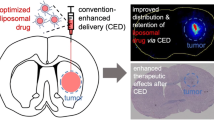Summary
Results of clinical trials with oxaliplatin in treating glioblastoma are dismal. Previous works showed that intravenous (i.v.) delivery of oxaliplatin did not increase the survival of F98 glioma-bearing Fisher rats. Low accumulation of the drug in tumor cells is presumed to be responsible for the lack of antitumor effect. In the present study, convection-enhanced delivery (CED) was used to directly inject oxaliplatin in brain tumor implanted in rats. Since CED can led to severe toxicity, the liposomal formulation of oxaliplatin (Lipoxal™) was also assessed. The maximum tolerated dose (MTD) of oxaliplatin was 10 μg, while that of Lipoxal™ was increased by 3-times reaching 30 μg. Median survival time (MeST) of F98 glioma-bearing rats injected with 10 μg oxaliplatin by CED was 31 days, 7.5 days longer than untreated control (p = 0.0002); while CED of 30 μg Lipoxal™ reached the same result. Compared to previous study on i.v. delivery of these drugs, their injection by CED significantly increased their tumoral accumulations as well as MeSTs in the F98 glioma bearing rat model. The addition of radiotherapy (15 Gy) to CED of oxaliplatin or Lipoxal™ increased the MeST by 4.0 and 3.0 days, respectively. The timing of radiotherapy (4 h or 24 h after CED) produced similar results. However, the treatment was better tolerated when radiotherapy was performed 24 h after CED. In conclusion, a better tumoral accumulation was achieved when oxaliplatin and Lipoxal™ were injected by CED. The liposomal encapsulation of oxaliplatin reduced its toxic, while maintaining its antitumor potential.




Similar content being viewed by others
References
Price TJ, Segelov E, Burge M, et al. (2013) Current opinion on optimal treatment for colorectal cancer. Expert Rev Anticancer Ther 13:597–611
Raez LE, Kobina S, Santos ES (2010) Oxaliplatin in first-line therapy for advanced non-small-cell lung cancer. Clin Lung Cancer 11:18–24
Okusaka T, Ikeda M, Fukutomi A, et al. (2014) Phase II study of FOLFIRINOX for chemotherapy-naïve Japanese patients with metastatic pancreatic cancer. Cancer Sci 105:1321–1326
Fouladi M, Blaney SM, Poussaint TY, et al. (2006) Phase II study of oxaliplatin in children with recurrent or refractory medulloblastoma, supratentorial primitive neuroectodermal tumors, and atypical teratoid rhabdoid tumors: a pediatric brain tumor consortium study. Cancer 107:2291–2297
Beaty O, Berg S, Blaney S, et al. (2010) A phase II trial and pharmacokinetic study of oxaliplatin in children with refractory solid tumors: a Children’s Oncology Group study. Pediatr Blood Cancer 55:440–445
Hartmann C, Weinel P, Schmid H, et al. (2011) Oxaliplatin, irinotecan, and gemcitabine: a novel combination in the therapy of progressed, relapsed, or refractory tumors in children. J Pediatr Hematol Oncol 33:344–349
Charest G, Sanche L, Fortin D, et al. (2013) Optimization of the route of platinum drugs administration to optimize the concomitant treatment with radiotherapy for glioblastoma implanted in the Fischer rat brain. J Neuro-Oncol 115:365–373
Fortin D, Desjardins A, Benko A, et al. (2005) Enhanced chemotherapy delivery by intraarterial infusion and blood-brain barrier disruption in malignant brain tumors: the sherbrooke experience. Cancer 103:2606–2615
Bobo RH, Laske DW, Akbasak A, et al. (1994) Convection-enhanced delivery of macromolecules in the brain. Proc Natl Acad Sci U S A 91:2076–2080
Biston M-C, Joubert A, Adam J-F, et al. (2004) Cure of fisher rats bearing radioresistant F98 glioma treated with cis-Platinum and irradiated with monochromatic synchrotron X-rays. Cancer Res 64:2317–2323
Rousseau J, Boudou C, Barth RF, et al. (2007) Enhanced survival and cure of F98 glioma-bearing rats following intracerebral delivery of carboplatin in combination with photon irradiation. Clin Cancer Res 13:5195–5201
Rousseau J, Barth RF, Moeschberger ML, Elleaume H (2009) Efficacy of intracerebral delivery of carboplatin in combination with photon irradiation for treatment of F98 glioma-bearing rats. Int J Radiat Oncol Biol Phys 73:530–536
Rousseau J, Barth RF, Fernandez M, et al. (2010) Efficacy of intracerebral delivery of cisplatin in combination with photon irradiation for treatment of brain tumors. J Neuro-Oncol 98:287–295
Yang W, Huo T, Barth RF, et al. (2011) Convection enhanced delivery of carboplatin in combination with radiotherapy for the treatment of brain tumors. J Neuro-Oncol 101:379–390
Yang W, Barth RF, Huo T, et al. (2014) Radiation therapy combined with intracerebral administration of carboplatin for the treatment of brain tumors. Radiat Oncol 9:25
Pasetto LM, D’Andrea MR, Rossi E, Monfardini S (2006) Oxaliplatin-related neurotoxicity: how and why? Crit Rev Oncol Hematol 59:159–168
Boulikas T, Pantos A, Bellis E, Christofis P (2007) Designing platinum compounds in cancer : structures and mechanisms. Cancer Ther 5:537–583
Walker MD, Green SB, Byar DP, et al. (1980) Randomized comparisons of radiotherapy and nitrosoureas for the treatment of maligant glioma after surgery. N Engl J Med 303:1323–1329
Stupp R, Mason WP, van den Bent MJ, et al. (2005) Radiotherapy plus concomitant and adjuvant temozolomide for glioblastoma. N Engl J Med 352:987–996
Charest G, Paquette B, Fortin D, et al. (2010) Concomitant treatment of F98 glioma cells with new liposomal platinum compounds and ionizing radiation. J Neuro-Oncol 97:187–193
Tippayamontri T, Kotb R, Paquette B, Sanche L (2012) Synergism in concomitant chemoradiotherapy of cisplatin and oxaliplatin and their liposomal formulation in the human colorectal cancer HCT116 model. Anticancer Res 32:4395–4404
Tippayamontri T, Kotb R, Paquette B, Sanche L (2014) New therapeutic possibilities of combined treatment of radiotherapy with oxaliplatin and its liposomal formulations (Lipoxal™) in colorectal cancer using nude mouse xenograft. Anticancer Res 5312:5303–5312
Rezaee M, Hunting DJ, Sanche L (2013) New insights into the mechanism underlying the synergistic action of ionizing radiation with platinum chemotherapeutic drugs: the role of low-energy electrons. Int J Radiat Oncol Biol Phys 87:847–853
Mathieu D, Lecomte R, Tsanaclis AM, et al. (2007) Standardization and detailed characterization of the syngeneic Fischer/F98 glioma model. Can J Neurol Sci 34:296–306
Shi M, Fortin D, Sanche L, Paquette B (2015) Convection-enhancement delivery of platinum-based drugs and LipoplatinTM to optimize the concomitant effect with radiotherapy in F98 glioma rat model. Investig New Drugs 33:555–563
Korn EL, Midthune D, Chen TT, et al. (1994) A comparison of two phase I trial designs. Stat Med 13:1799–1806
Ausubel FM, Brent R, Kingston RE, et al. (1994) Current protocols in molecular biology. John Wiley and sons, New York
Allard E, Passirani C, Benoit J-P (2009) Convection-enhanced delivery of nanocarriers for the treatment of brain tumors. Biomaterials 30:2302–2318
Saito R, Krauze MT, Noble CO, et al. (2006) Convection-enhanced delivery of Ls-TPT enables an effective, continuous, low-dose chemotherapy against malignant glioma xenograft model. Neuro-Oncology 8:205–214
Perlstein B, Ram Z, Daniels D, et al. (2008) Convection-enhanced delivery of maghemite nanoparticles: increased efficacy and MRI monitoring. Neuro Oncol 10:153–6131
Raymond E, Chaney SG, Taamma A, Cvitkovic E (1998) Oxaliplatin: a review of preclinical and clinical studies. Ann Oncol 9:1053–1071
Stathopoulos GP, Boulikas T, Kourvetaris A, Stathopoulos J (2006) Liposomal oxaliplatin in the treatment of advanced cancer: a phase I study. Anticancer Res 26:1489–1493
Wang D, Lippard SJ (2005) Cellular processing of platinum anticancer drugs. Nat Rev Drug Discov 4:307–320
Tashiro T, Kawada Y, Sakurai Y, Kidani Y (1989) Antitumor activity of a new platinum complex, oxalato (trans-l-1,2-diaminocyclohexane)platinum (II): new experimental data. Biomed Pharmacother 43:251–260
Tippayamontri T, Kotb R, Paquette B, Sanche L (2013) Efficacy of cisplatin and Lipoplatin™ in combined treatment with radiation of a colorectal tumor in nude mouse. Anticancer Res 33:3005–3014
Stathopoulos GP, Boulikas T (2012) Lipoplatin formulation review article. J Drug Deliv 2012:581363
Acknowledgments
We would like to thank Dr. T. Boulikas for generously providing Lipoxal™, Dr. A-M Crous-Tsanaclis for her assistance in reviewing the histological samples and Dr. A.D. Bass for helpful suggestions and corrections.
Author information
Authors and Affiliations
Corresponding author
Ethics declarations
Conflict of interest
none.
Funding
This work was supported by Canadian Institutes of Health Research (grant # MOP 81356). David Fortin, Léon Sanche and Benoit Paquette are members of the Centre de Recherche du CHUS supported by the Fonds de la Recherche du Québec en Santé.
Rights and permissions
About this article
Cite this article
Shi, M., Fortin, D., Paquette, B. et al. Convection-enhancement delivery of liposomal formulation of oxaliplatin shows less toxicity than oxaliplatin yet maintains a similar median survival time in F98 glioma-bearing rat model. Invest New Drugs 34, 269–276 (2016). https://doi.org/10.1007/s10637-016-0340-0
Received:
Accepted:
Published:
Issue Date:
DOI: https://doi.org/10.1007/s10637-016-0340-0




